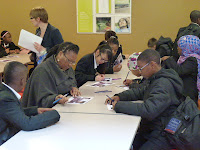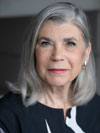 |
| The tortuous road through Oak Creek Canyon |
Friday the Thirteenth - the Grand Canyon
The wind rises and sky darkens as we take
the scenic route out of Sedona through Oak Creek Canyon up into the mountains.
The Garmin valiantly tries to show the hairpin bends of the road but eventually
gives up and the car icon simply spins round and around on the screen. We reach
the peak and pull into the national park viewing area. It is also an approved
trading post for native American Indians to sell their handmade arts and
crafts. A cluster of stalls filled with jewellery, pottery and feathered dream
catchers are ranged in line. The Navajo Indians huddled under hoods and
umbrellas against the biting wind are cheerful, charming and informative. We
buy intricately woven bracelets for the grandchildren, each with a sheet explaining
the various images.
We walk to the viewing point. The view is
spectacular. Huge ravens soar and dip above our heads. Excitable Japanese and
Italian tourists arrive, crying out "Bald eagles, bald eagles!" Their
jocular and patient guide does his best to convince them otherwise, but in the
end decides to opt for the possibility that they are turkey vultures. This
seems to satisfy them and after various combinations of photo opportunity all
move back to their minibus.
We too retreat to the warmth of our vehicle and
continue down the scenic route to Flagstaff. After a rather challenging
negotiation around the town we find the road west to Los Angeles and then
strike off due north to our destination, the Grand Canyon. Skies to the west have encouraging
stripes of blue. Skies to the east are distinctly grey.
 |
| First view of the Grand Canyon |
The Ranger issuing our pass at the entrance
to the Grand Canyon National Park tells us that there is a 70 per cent chance
of precipitation, between 2 and 5 inches. Precipitation means snow. But shouldn't
be a problem, she smiles. Rod looks thoughtful.
We check into Yavapai Lodge, where a tall
chap with wire-rimmed glasses, whispy beard and prominent Adam's apple welcomes
us cheerily. He too assures us that even if there is snow, it shouldn't be a problem,
although he would advise against taking the tortuous scenic road back Flagstaff
if the weather does change.
Our room on the second floor is large,
comfortable, nicely furnished and very warm, with a wall of windows overlooking
the pines that creates the feeling of being in a tree house. We go back to the
car and open the boot to get out our suitcase. It is not there.
I stare in disbelief. How come someone
managed to steal it without setting off the alarm? Was it the two grubby
hippies munching burgers in a battered station wagon parked next to us when we
stopped at the art gallery in Sedona? I sit down on a rock on the pathway,
thinking of my computer and my jewellery roll. I also remember jokingly telling
friends that as we were visiting the Grand Canyon on Friday 13 I would stay
away from the edge. The jinx has clearly taken a different form.
Rod quietly says, "I left the suitcase
in Sedona."
I remember him carrying it down the stairs
from the room. "In the car park?" I ask.
"No, in the corner of the registration
office," he replies. Relief that it has not been stolen or left in a car
park overrides panic at the loss of a computer. Even lack of fresh underwear,
contact lenses and make-up are minor issues. A call to the Canyon Inn, Sedona
confirms that they have our case and have even sent us an email, not yet
received due to intermittent reception.
 |
| Extraordinary glow at sunset |
 |
| Dedicated snapper |
There is only one thing to do - go and
take a good look at the reason for making the journey. And it is worth making.
Like other extraordinary sights of the world, photograph and film do not do
justice to the sheer vastness, grandeur and colour of the Grand Canyon. We walk
a stretch of the Rim Trail, visit the geological museum and take lots of photographs,
despite knowing that many of them will look like rosy porridge.
We call into the General Store, which
proves to be impressively large, well stocked with fresh food, household goods,
clothing, crampons and hiking gear. Toothbrushes are purchased, together with
milk and muffins for breakfast, humous, crackers and red wine for a restorative
appetiser. As we return to the lodge, a mule deer strolls nonchalantly along
the edge of the car park, nibbling the grass.
Reading the park newspaper reveals a wide
range of activities, including a talk this evening entitled Gold, Glory and
discovering the Grand Canyon. We set off, wearing all the clothes available
from our limited stock, topped with our windproof macs. The auditorium fills
with a mixture of mature, serious types, young hikers and multiple generation
campers with offspring ranging from babies to teenagers, including a collection
of what turns out to be Noisy and Unmanageable Toddlers.
The young, bearded Ranger lecturer strides
energetically around, interspersing rapid fire questions to the audience (What
make the Grand Canyon grand? What did you learn today?) with a galloping
ideosyncratic and entertaining history of Spanish kings, errant daughters and
conquistadors who wandered the desert like ancient mariners searching for
Cibola and the seven cities of gold.They didn't find the gold, but they did
discover the Grand Canyon.
The Noisy and Unmanageable Toddlers cause
mayhem, impervious to the shushes and increasingly disgruntled comments from the
main audience and a plea from the Ranger. Eventually relegated to the lobby by
their spookily silent mothers in floaty skirts and wool beanies, they continue
to run amok. Nobody bothers to shut the doors but eventually the volume dies
down. At the end of the lecture the Ranger tells us to leave the site quickly
as street lighting is kept to the minimum in the park in order to reduce light
pollution. We head off for dinner at Bright Angel Lodge, the historic place we
would have liked to stay but which, like El Tovar, is booked a year in advance.
 |
| Warm welcome at Bright Angel Lodge |
Bright Angel Lodge is warm, welcoming
and stylish. Designed by the innovative architect Mary Jane Colter in 1935, it
is built of wood and stone, with a blazing fire in a magnificent fireplace to
greet us as we walk through the lobby door. Above the fireplace hangs a large
carving of the thunderbird, the Bright Angel of the canyon and namesake of the
lodge. Sadly the history room is closed, so we cannot admire at first hand the
fireplace which Mary Jane Coulter had constructed of rocks to match the
geological formation of the canyon itself.
Regarded as the best-known unknown architect in the national parks, Mary Jane
Colter's philosophy was that a building should grow out of its
setting. Her style of architecture became known as National Park Service
Rustic. “It should belong to its environment as though indigenous to that
spot,” according to her biographer Virginia Grattan.
Colter became interested in building and
design whilst working as an apprentice architect to help fund her art studies.
She spent 15 years as an art teacher but in 1902 she found a summer job with the Fred
Harvey Company which specialized in railway stations and hotels. After doing
interior decoration for the Indian Building adjacent to the new Alvarado Hotel
in Albuquerque, Colter was commissioned to design the Hopi House at the Grand
Canyon.
 |
| Mary Jane Colter |
Although these projects were successful, it
was another eight years before she was offered a permanent position at the Fred
Harvey Company. But she remained there as architect and designer for 46 years
and was responsible for 21 projects, including La Fonda Hotel in Santa Fe, La
Posada in Winslow and the Union Stations in Kansas City, St. Louis and Los
Angeles.
Despite her regular commissions and the
magnificence of her designs, success did not come easily in a male-dominated
profession. She was not listed as architect on many of her buildings and her
name did not achieve the recognition of many of her peers such as Frank Lloyd
Wright and Irving Gill.
Today all six of her public structures within the park
are included in the Mary Jane Colter National Landmark District or have
National Landmark Properties status.
More people tour a Mary Jane Colter creation in a single busy weekend
than visit some of Frank Lloyd Wright’s most famous sites in a year. A
satisfying thought.
 |
| Endless vista |
We go to the large dining room, combining rustic wooden panels with ornate light fittings, intimate alcoves and tables to accommodate a dozen or more people. We eat excellent steak with fries and salad and share a rainbow sorbet, at a very reasonable price. I note how our fellow diners wrap up in multiple layers as they leave, discussing how cold the weather has become. I buy a pair of bright Navajo patterned socks from the excellent shop (the closest I get to taking home Indian weaving).
We find the car and start to find our way
back in the intense darkness to Yavapai Lodge. Our Garmin lady descends into a
semi-hysterical babble, trying to guide us on to non-existent roads, one way
streets and dead ends. As she tries to persuade us to turn right onto the
railroad track, I consign her to the glove compartment and just as we think we
shall have to resort to navigating by the stars, we spot signs that relate to
the rather vague map and triumphantly locate the lodge. After a warming glass
of red wine, to compensate for lack of night attire, we go to bed.
All photographs by Sandi Rhys Jones, except for portrait of Mary Jane Colter, from the National Parks Archive.







































